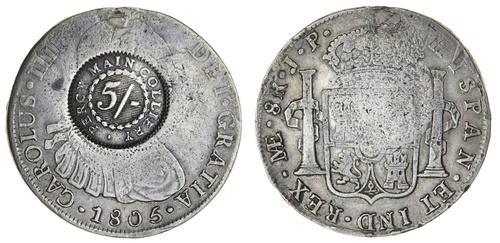
Auction: 19025 - Ancient, Indian and Islamic, British and Foreign Coins and Commemorative Medals
Lot: 1303
Northumberland, Percy Main {Howdon Panns} Colliery, Countermark Dollar of 5-Shillings, stamped over 8-Reales, 1805-JP, Lima, laureate, draped and cuirassed bust right, serrated circular punch obscuring neck and face inscribed
Spink 90, 16 March 1992, lot 529 - £390
Hans Schulman, 14-15 February 1958, lot 2641 (illus.) - $75.00
D S Napier Esq., Glendining, 30 May 1956, lot 286 (part) - £15.0.0 (to Schulman)
Glendining, 18-20 September 1929, lot 169 - £5.15.0
The sinking of the mine shaft began in 1796, but was abandoned by 1851 because of persistent flooding
Subject to 20% VAT on Buyer’s Premium. For more information please view Terms and Conditions for Buyers.
Sold for
£3,500
Sale 19025 Notices
"Pre-sale note": This countermark has been the subject of long-running academic dispute, first arising in the 1960s, when Bert Seaby opined that its appearance was highly reminiscent of that of other known 20th Century concoctions such as those found amongst the Castlecomer series. Manville, in his 2001 publication "Tokens of the Industrial Revolution: Foreign Silver coins countermarked for use in Great Britain c. 1787-1828" distanced himself from Seaby's earlier commentary, concluding: "In sum while a vague uneasiness persists about the authenticity of the Percy Main countermark - there is insufficient evidence to condemn the mark as a forgery". However, following further remarks from Michael Dickinson post-publication (cf. Spink Numismatic Circular, 2003, pp.130-132), Manville revised his opinion and subsequently accepted the earlier arguments (BNJ 2002, pp. 147), re-annotating the variety as M.X106) - to indicate that the 'fantasy' attribution for the piece is now generally accepted."




